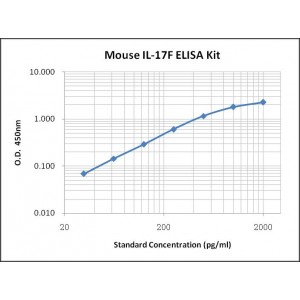More info
Assay Range | 31.2-2,000 pg/mL |
Sensitivity | 10.0 pg/mL |
Specificity | No cross-reaction with other related substances detected |
Size | 96T |
Storage | Store at 2 - 8ºC. Keep reconstituted standard and detection Ab at -20 ºC |
Assay Principle | Sandwich ELISA |
Sample Volume | 100 µL final volume, dilution factor varies on samples |
Sample Type | serum, plasma or cell culture supernatant |
Detection Method | Chromogenic |
Kit Components
1. Recombinant Mouse IL-17F standard: 2 vials
2. One 96-well plate coated with Mouse IL-17F Ab
3. Sample diluent buffer: 12 mL - 1
4. Detection antibody: 130 µL, dilution 1:100
5. Streptavidin-HRP: 130 µL, dilution 1:100
6. Antibody diluent buffer: 12 mL x1
7. Streptavidin-HRP diluent buffer: 12 mL x1
8. TMB developing agent: 10 mL x1
9. Stop solution: 10 mL x1
10. Washing solution (20x): 25 mL x1
Background
Interleukin-17F (IL-17F), is a member of the Interleukin 17 (IL-17) family which consists of IL-17 (A), IL-17B, IL-17C, IL-17D, IL-17E (also called IL-25), and IL-17F. IL-17 family proteins are characterized by a conserved cysteine knot fold near the C-terminus. Except that IL-17B exists as a non-covalently linked dimer, all IL-17 family members are disulfide-linked dimers. IL-17 family proteins are proinflammatory cytokines that induce local cytokine production and play a role in the regulation of immune functions. Mouse and human IL-17F share 55% sequence identity.
IL-17F is expressed in activated CD4+ T cells and activated monocytes. Structurally and functionally, IL-17F is most closely related to IL-17. For example, IL-17F stimulates production of IL-6, IL-8, G-CSF, and regulates cartilage matrix turnover by increasing matrix release and inhibiting new matrix synthesis. IL-17F also inhibits angiogenesis and induces production of IL-2, TGF-β, and monocyte chemoattractant protein-1 in endothelial cells. IL-17F interacts with specific receptors to trigger cellular activation. The IL-17 receptor family consists of five receptor proteins IL-17RA, B, C, D and E. IL-17RA binds both IL-17A and IL-17F and is expressed in many different cell types and tissues, such as vascular endothelial cells, peripheral T cells, B cell lineages, fibroblast, myelomonocytic cells, marrow stromal cells and lung. Both IL-17A and IL-17F signaling require a cell surface heterodimeric complex composed of IL-17RA and IL-17RC and the absence of either receptor results in ineffective signal transduction.


